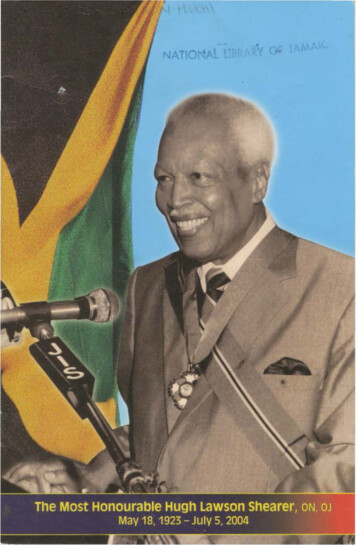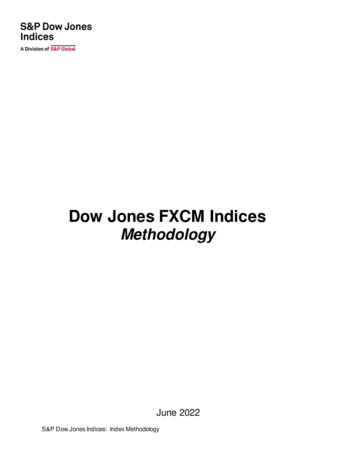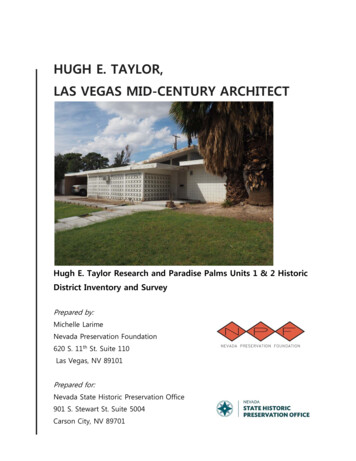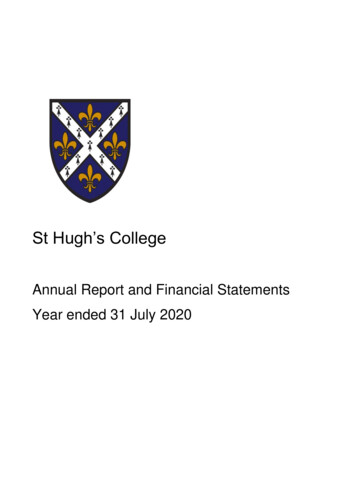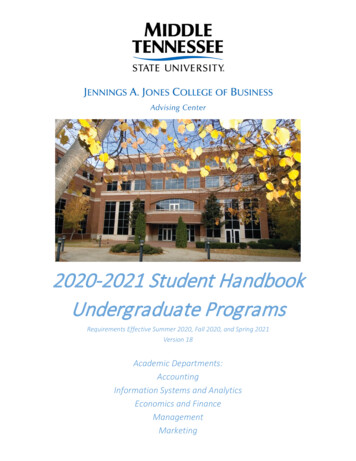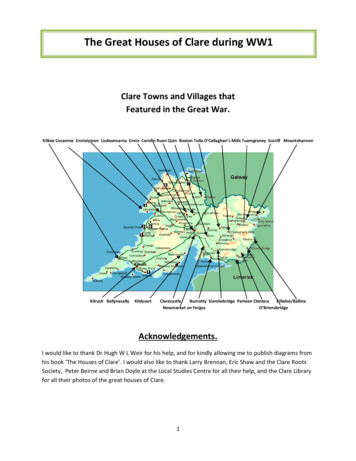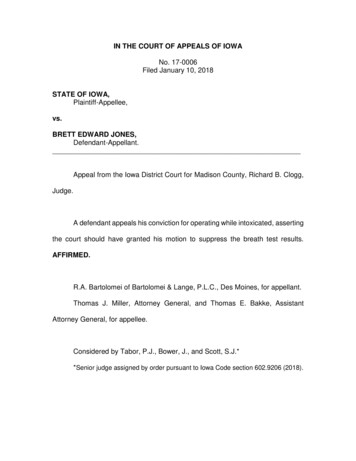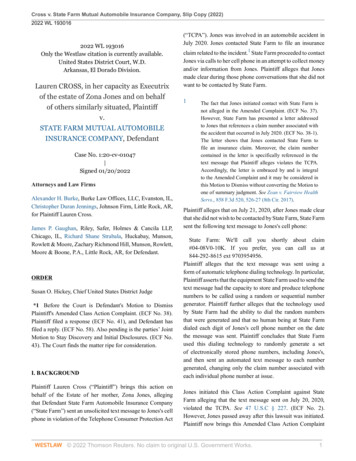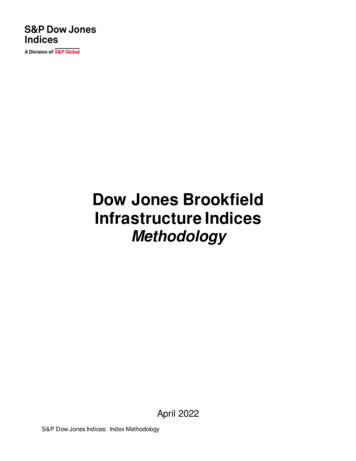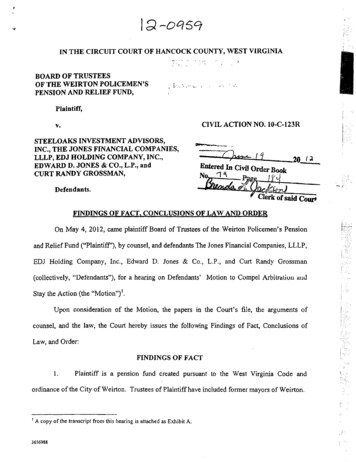
Transcription
Major Hugh JonesDepartment of Social SciencesUnited States Military Academy
Risk& Uncertainty in Military Operations US Army definition of risk & uncertainty Army Risk Mitigation Composite Risk Management ArmyUncertainty Mitigation Information-Focused Solution Action-Focused Solution Conclusion
Carl von Clausewitz, 1780 - 1831"War is the realm of uncertainty; three-quarters of the factors onwhich action in war is based are wrapped in a fog of greater orlesser uncertainty “Clausewitz, Carl von. On War.
The US Army separates risk and uncertainty.Risk Known hazards All hazards, tactical or accidental, that have thepotential to injure or kill personnel, damage or destroyequipment, or otherwise impact mission effectiveness.US Army FM 5-19: Composite Risk Management. pg 1-1.Uncertainty Unknown or ambiguous hazards Unpredictability and ambiguity stemming from thecomplex and highly interactive nature of militaryoperations, further complicated by inherent humaninteraction and a thinking enemy.(Composite definition based on US Army FM 6-0: Mission Command. pg 1-10.)
The primary decision-making process for identifying hazards and controlling risksacross the full spectrum of Army missions, functions, operations, and activities.US Army FM 5-19: Composite Risk Management.
Information-focused Solution1. Reduces uncertainty by collecting more and better data,increasing information-processing capability, anddisseminating relevant information.US Army FM 6-0: Mission Command. pg 1-11. Counter Intelligence & Military DeceptionMost Likely Enemy Course of ActionMost Dangerous Enemy Course of Action“Red Teaming” (Devil’s Advocate)Action-focused Solution2. Focuses on designing, training, and maintainingorganizations capable of managing and coping withuncertainty as part of normal operations.US Army FM 6-0: Mission Command. pg 1-11.
Sun Tzu, 544 BC – 496 BC“Thus, what enables the wise sovereign and the good general to strike andconquer, and achieve things beyond the reach of ordinary men, isforeknowledge [intelligence]. Now this foreknowledge cannot be elicited fromspirits; it cannot be obtained inductively from experience, nor by anydeductive calculation.”Sun Tzu. The Art of War.
Information Management The provision of relevant information to the right person atthe right time in a usable form to facilitate situationalunderstanding and decision making. Information is collected, processed, stored, displayed, anddisseminated.US Army FM 6-0: Mission Command. pg 3-10.Relevant Information All information of importance to the commander and staffin the exercise of command and control.US Army FM 6-0: Mission Command. Pg 3-5. Facilitates collaborative planning and helps achieveshared situational understanding.US Army FM 6-0: Mission Command. Pg 3-8.
To continuously acquirerelevant information by anymeans.US Army FM 2-0: Intelligence. pg 1-21.Information-push system:Collects information by pushing it fromthe source to the user, by schedule oravailability.Information-pull system:Users request information as needed.
Adds meaning to data andinformation throughprogressively higher-level andcomplex cognitive methods.US Army FM 6-0: Mission Command. Pg 3-14.Filter Fuse Prioritize Understand
To retain relevant information in any form, for orderly, timely retrieval anddocumentation, until it is needed for exercising command and control.Flexible common databases with sorting, storage, and query capability arepreferred for information storage.US Army FM 6-0: Mission Command. Pg 3-15.
To represent relevant information in a usable, easily understood audio or visualform tailored to the needs of the user. (Graphic, written, or verbal narrative.)US Army FM 6-0: Mission Command. Pg 3-16.
To communicate relevant information of any kind from one person or place toanother in a usable form by any means to improve understanding or to initiateor govern action.Broadcast or point-to-point dissemination.US Army FM 6-0: Mission Command. Pg 3-16.
Actions conducted to mislead anenemy commander Provokesan enemy commander tohesitate or commit a serious mistake Introduces uncertainty into theenemy’s estimate of the situation Requires integration into the overalloperation Requires a reasonably accurateassessment of the enemy’sexpectationsUS Army FM 3-0: Operations. Pg 7-8.
At a minimum every plan considers and addresses the most likely scenario andthe worst case scenario: Most Likely Enemy Course of ActionUS Army FM 5-0: The Operations Process. Pg D-2. Most Dangerous Enemy Course of Action
A structured, iterative process that provides an independent capability tochallenge plans in the context of the operational environment and from ourpartners’ and adversaries’ perspectives.Red Teams are tasked to: Broaden understanding. Assist in framing problems anddefining end state. Challenge assumptions. Ensure adversary and otherperspectives are considered. Aid in identifying friendly and enemy vulnerabilities and opportunities. Anticipate cultural perceptions. Conduct independent critical reviews and analyses.US Army FM 5-0: The Operations Process. Pg 1-7.
Helmuth von Moltke, 1800-1891“ no plan of operations extends with any degree of certainty beyond the firstencounter with the main enemy force ““The advantage which a commander thinks he can attain through continued personalintervention is largely illusory. By engaging in it he assumes a task that really belongsto others, whose effectiveness he thus destroys. He also multiplies his own tasks to apoint where he can no longer fulfill the whole of them.”von Moltke, Helmuth. Essays, speeches, and memoirs of Field Marshal Count Helmuth von Moltke.
Acknowledges some uncertainty is unavoidable.Focuses on designing, training, and maintainingorganizations capable of managing and coping withuncertainty as part of normal operations.US Army FM 6-0: Mission Command. Pg 1-11.Mission Command Decentralized execution based on mission orders. Encourages calculated risks to create opportunities.US Army FM 6-0: Mission Command. Pg 1-17.
Leaders exercise disciplinedinitiative within the commander’sintent to accomplish missions.Requires trust and mutualunderstanding.Mission command rests on fourelements: Commander’s intent. Subordinates’ initiative. Mission orders. Resource allocation.Sacrifices direct control forinitiative and action versuspassivity and ponderousdecision-making.US Army FM 6-0: Mission Command. Pg 1-15.
Describe the boundaries ofinitiative while maintainingunity of effort. Purpose Decisive point Key Tasks Desired End StateA clear, concise statement of what the force must do and theconditions the force must establish in order to achieve the desiredend state.US Army FM 3-0: Operations. Pg 5-10.
Subordinates are required,not just permitted, toexercise initiative when anopportunity or threatpresents itself.The responsibility for deciding and initiating independent actionswhen the concept of operations no longer applies or when anunanticipated opportunity leading to achieving the commander’sintent presents itself.US Army FM 6-0: Mission Command. Pg 1-17.
Ambiguity and uncertainty are integrated into training.Flexibility is encouraged An“approved solution” is not rigidly enforced, but success isdefined by achieving the desired outcome. Doctrine provides a framework that is adjusted as necessary.US Army FM 7-0: Training for Full Spectrum Operations. Pg 54.
Risk Known hazardsIdentified, Assessed, Controlled, EvaluatedUncertainty Unknown or ambiguous hazards1. Information-focused Solution Information Dominance2.Action-focused Solution Flexible organizations Mission Command Sacrifices direct control for initiative and action
Academic: MBA, Finance (Investments) and Management, Duke University, 2009 BS, Systems Engineering, USMA, 1999 Branch: Infantry Military Career: Instructor of Economics & Finance, West Point Airborne Reconnaissance Troop Commander Airborne Rifle Company Commander Assistant Operations Officer Platoon Tactical Trainer/Senior Walker, US Army Ranger School Battalion Personnel Officer Support Platoon Leader Company Executive Officer Air Assault Rifle Platoon Leader Deployments OIF – “Surge” - Baghdad, Iraq OIF – CJSOTF – OCFI, Iraq Operation All American Assist – New Orleans, LA (Katrina) Operation Joint Guardian – Kosovo
The primary decision-making process for identifying hazards and controllingrisks across the full spectrum of Army missions, functions, operations, andactivities.1. Identify hazards.2. Assess hazards to determine risk. 3.Develop controls & make risk decisions. 4.5.Assess probability of occurrenceEstimate severity of an occurrenceDetermine resultant level of riskDevelop ControlsFind control measuresReassess risk with controls appliedMake risk decisionsImplement controls.Supervise and evaluate. Supervise controlsEvaluate efficacy of controlsUS Army FM 5-19: Composite Risk Management.
3 Panther Risk Management WorksheetPage1 of 61. MSN / TSK:2. DTG BEGIN: 11 Apr 05END: 19 Apr 05PLT LFX Range 68/ OP 93. DATE PREPARED: 1 Mar 054. PREPARED BY: MAJ Smith, 3-505th PIR Operations Officer(Rank/Last Name/Duty Position)5. HAZARDS7. CONTROLSAMMUNITION: Mix blankand ball ammo, fire at ASPMSBF: Fratricide firing w/inMSD, Injury due tomalfunction, injury due tosignals (pyro)HAMMUNITION: PSGconfirms all blank adaptorsremoved and pax checkedfor blank ammo prior toissuing ball ammunition,fire extinguisher charged atASP, no smoking within 50’Blank and Live Ammunitionstored and issued inseparate locations. ASPsseparated by wire. Lightsavailable for night issue.SBF: SBF Rehearsals blankday/night, ID L/R limits,rehearse immediatecorrective actions formalfunction, clearly markedmaneuver element, practiceemploying signals,rehearse CASEVAC planduring fire/TEWT, OC withcommo designated foreach gun. Pax receive minof 5 hours rest prior toexecuting range. Soldierswear IBA w/ SAPIMaintain 15 degrees frommaneuver11. OVERALL RISK LEVEL AFTER CONTROLS ARE IMPLEMENTED (CIRCLE ONE):LOWMODERATEHIGHEXTREMELY HIGH8. HOW TOIMPLEMENTPCIs/PCCs Prior toexecution, White lightcheck at night.Soldiers load ownmagazines; confirmblank or live.Ammo NCOICseparates live ammofrom blk ammo atASPBrass and ammocheck after eachiteration.15/40 degree ruleRehearsals9. HOW TOSUPERVISECoC, OC, PL, PSG,and SQD LDRsCoC, OC, and SQDLDRs12. RISK DECISION AUTHORITY:LTC John Smith, BN CDR10.RESIDUALRISK LEVELLM
Arthur Wellesley, 1769 - 1852"All the business of war, and indeed all the business of life, is to endeavor to find outwhat you don't know by what you do; that's what I called 'guessing what was at theother side of the hill.“Wellesley, Arthur (1st Duke of Wellington).
Priority Information Requirements: Intelligenceneeded to understand the adversary or theoperational environment.Friendly Forces Information Requirements: Intelligenceneeded to understand the status of friendlyforces or supporting capabilities.Essential Elements of Friendly Information: Criticalaspects of friendly operations that, if known, wouldcompromise, lead to failure, or limit success. Protected through military deception & counter-intelligenceUS Army FM 3-0: Operations. Pg 5-9.
Task organization Commander’s intent Concept of operations Mission of the force who, what, when, where, and whySubordinates’ missions Essential coordinating instructions. A technique for completing combat orders that allowssubordinates maximum freedom of planning and action inaccomplishing missions and leaves the “how” of missionaccomplishment to subordinates, guides initiative.US Army FM 6-0: Mission Command. Pg 1-17.
Commanders allocate enough resources for subordinates toaccomplish their missions. In the context of mission command,commanders consider information a resource, and share itthrough all levels of command.US Army FM 6-0: Mission Command. Pg 1-18.
The US Army separates risk and uncertainty. Risk Known hazards All hazards, tactical or accidental, that have the potential to injure or kill personnel, damage or destroy equipment, or otherwise impact mission effectiveness. US Army FM 5-19: Composite Risk Management. pg 1-1. Uncertainty Unknown or ambiguous hazards
